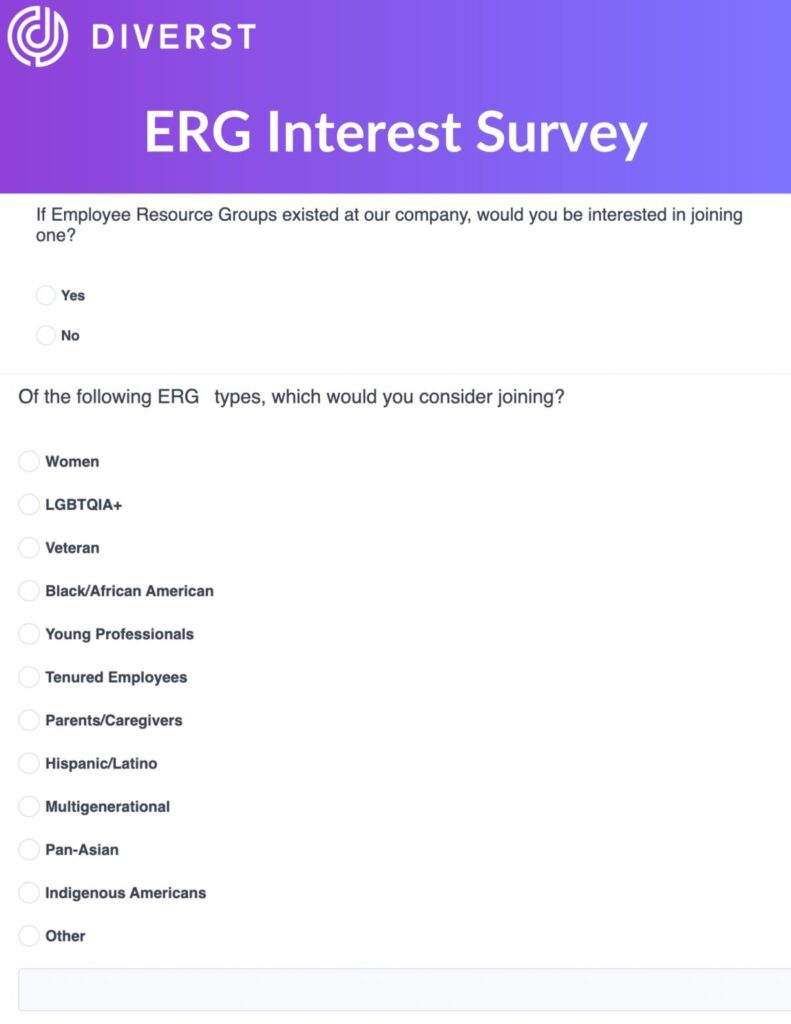
ERG
How to Start an ERG in 6 Steps: ERG Launching Guide

Sam Cook
Content Director and Employee Engagement Researcher
Oct 18, 2023
Among the few employee engagement and development programs seen as “an absolute must-have,” Employee Resource Groups quickly rise to the top. Once a company has reached a certain size, ERGs become a natural extension of that organization’s broader culture and mission. Employees strongly desire to engage and connect within smaller communities where they share affinities. Employee Resource Groups provide them with the needed structure to streamline that engagement. When launched and structured well, ERGs significantly contribute to key people metrics that companies track, including employee retention, employee engagement, productivity, performance appraisal ratings, and even employee net promotor scores.
As with most programs, the hardest part of an ERG is getting it off the ground. In this blog post, we’ll help get you started with a step-by-step guide covering how to start an ERG from scratch.
The Starting Framework for Launching an ERG
If you’re building your program from scratch, we recommend you bookmark his page. The information here is rather extensive, and you may want or need to come back to reference some of these materials.
With that out of the way, let’s begin with the higher-level framework. Starting an ERG program requires a step-by-step approach that takes into consideration all of the following:
- Existing demand from employees
- Organizational goals that the ERG program could impact
- ERG budgeting and financial considerations
- Get Executive-level support for ERGs
- ERG design structure and format, including supporting tools and technologies
- Internal marketing to boost ERG participation
These categories are laid out in a logical timeline for effective execution.
E.g., you want to understand what the demand for ERGs looks like at your company before you consider how the potential ERGs you’d launch align with organizational goals. And you want to have budget estimates and requests in place before you try to persuade executive leaders to buy into ERGs as an engagement strategy.
As the saying goes, don’t put the cart before the horse. From here, we’ll discuss your basic needs for each of these 7 steps.
Step 1: Determine What Demand Exists for ERGs
You’re going to notice a common thread throughout these steps: data. Data should be the driving force behind your decision-making. It not only helps you make the right decisions but also adds weight to those decisions when it comes time to persuade others that your approach is the right one.
Creating an ERG starts with understanding the existing demand for ERGs in your organization. There are two ways to do this, both of which you should utilize:
- Internal demographic data
- Demand/interest survey responses
We’ll start with that first one since it’s the easiest to obtain. Ideally, your company should have internal demographic data on your employees.
Internal demographic data
Internal demographic data is the type of data you collect on employees when you hire them. It’s the data that exists within your HRIS system that you regularly track, and in an ideal world, it’s regularly updated when something about that employee’s demographics change.
You likely have the following some or all of the following readily available:
- Age
- Gender
- Education level
- Tenure
- Job title
- Location
- Ethnicity
- Nationality
- Veteran Status
We’ve found that the most common types of ERGs within Fair360’s DiversityInc Top 50 companies are those that provide space for Women, LGBTQIA+, People with Disabilities, Veterans, and Black employees (in that order from). Consequently, the data you have at hand should already be informative of whether you have the population size to support the most common types of ERGs.
Note that “having the population size” is not the same as “having interesting.” Just because you have 200 employees who could populate a Women’s ERG doesn’t mean you’re going to have 200 participants after you launch the program. You’ll need to assume some percentage won’t join at all, and you’ll need to determine what the baseline participation rate is considered acceptable.
Keep in mind that the end goal for your ERGs is going to be tied to some measurable outcomes that relate to business objectives. For example, if you want to decrease employee retention, look to AT&T, which increased Black employee retention by 86% among its ERG participants. That’s certainly aspirational, but it’s the hallmark of a well-run program.
And when you consider the cost of employee replacing an employee is 1/2 to 2x that employee’s salary, at an average salary of $70,000 per year, retaining just one employee thanks to an ERG could save your company between $35,000 to $140,000. Retain 10 employees, and you’re looking at $350,000 to $700,000 in retention savings. So, even getting 10 of those 200 women to participate in an ERG (5% participation rate, which is crazy small) would be a cost saver and likely be a significant ROI for the program.
Demand or interest survey data

Combine the demographic data you have with employee interest surveys. Note that every employee can benefit from ERGs, not just certain demographics. There are potential ERGs for every employee; you just need to know if there is demand for it. And your HRIS data is not going to cover all potential demand, as there are many affinities that exist that you may not have visibility into because you can’t really ask about it.
For example, you won’t likely have data on who identifies as LGBTQIA+ at your organization. Not everyone is willing to share that information, and you probably don’t (read: legally shouldn’t be) ask for that information when you hire. Employees can, however, volunteer to give you that information.
Your interest survey should be simple. The image included in this section is an example of a simple survey you can send out to your organization that would get the job done.
Two questions are all you need, all multiple choice:
- If Employee Resource Groups existed at our company, would you be interested in joining one?
- Of the following ERG types, which would you consider joining?
These questions will help you understand what percentage of employees of all your population would consider joining an ERG and then which ERGs they would join. You will likely want to make both multiple-choice questions with the option for writing a response in the second question. And for the ERG types question, allow participants to select more than one.
What’s a good ERG participation rate?
This entire discussion leads to a very important question we hope you’ve already asked in your head: How many employees do I need to support launching an official ERG?
The answer: It depends. Quite obviously, you need more than 1 employee to start any ERG. And you aren’t likely to get executive buy-in for any program with just one ERG participant. So, having just one veteran at your organization probably means you won’t get much demand for launching an ERG for veterans.
The minimum number of employees needed to support an Employee Resource Group can vary depending on various factors, such as the size of your organization, the scope of the ERG’s activities, and available resources. However, a general rule of thumb is to start with at least 10-15 active members, as you’ll need to consider different roles and responsibilities within those groups.
Some questions to consider as you plan out your ERGs at this step include:
- Scope and scale: What is the anticipated scope and scale of the ERG’s activities? Will it require frequent events, trainings, or campaigns?
- Company size: In a smaller company, you might need a larger percentage of the workforce to participate for the ERG to be seen as legitimate or to have the manpower to accomplish its goals.
- Company support: What level of support can you expect from the company regarding funding, time, and resources?
- Virtual vs. in-person: Will the ERG operate virtually, in-person, or a hybrid of both? Virtual operations could potentially require fewer active members.
- Industry norms: Are there existing ERGs in your industry that you can benchmark against?
While there’s no one-size-fits-all answer, having a core group of at least 10-15 active members and a clear structure can serve as a strong foundation for an effective ERG. If you’re planning to launch an ERG at an enterprise company, you’ll likely have far more participants than that, but even a small-to-midsized company could get that level of participation as long as the ERG is targeted to an employee affinity with a large enough potential population to support it.
Step 2: Align with Organizational Goals
Aligning your ERG program with organizational goals is absolutely critical to getting executive support. You also want to make sure this is covered and ideated in detail before you meet with executive leaders.
This is actually a fairly simple process, although it may require some internal politicking on your part if you don’t have access to all of the information you need. To align your ERG program with key organizational goals, you need access to two things:
- A list of organizational goals
- Data that shows how ERGs could impact those goals
The former is something you may or may not have direct access to, depending on your level within the organization. If you’re at a manager level or below, you may need to poke around and ask someone at the Director level or above what organizational goals are currently important to your company. It may seem intuitive to only focus on HR-specific goals. But you want to be creative and think outside the box so you can explain how ERG programs can influence goals across the organization.
Here are some common organizational goals that exist that you may want to inquire about:
Financial goals:
- Revenue growth: Increasing sales revenue through customer acquisition and retention.
- Profitability: Maximizing profit margins by controlling costs and increasing efficiency.
- Cash flow management: Ensuring liquidity to cover operational expenses and investments.
Operational goals:
- Efficiency: Streamlining processes to make the best use of resources.
- Quality assurance: Maintaining or improving the quality of products or services.
- Scalability: Building a model that can handle increased demand without proportionally increasing costs.
Customer-focused goals:
- Customer satisfaction: Improving the quality of customer service and product experience.
- Customer retention: Keeping existing customers through loyalty programs or high-quality service.
- Market expansion: Entering new markets or customer segments.
Employee and talent goals:
- Employee satisfaction: Improving workplace conditions, benefits, or culture to retain talent.
- Training and development: Upskilling employees to meet current and future challenges.
- Recruitment: Attracting qualified talent for key roles within the organization.
- Employee retention: Retaining more employees and reducing turnover and replacement costs.
Strategic goals:
- Innovation: Developing new products, services, or processes.
- Competitive positioning: Gaining market share or establishing a unique selling proposition.
- Partnerships and alliances: Forming relationships with other organizations for mutual benefit.
Sustainability and social responsibility goals:
- Environmental impact: Reducing carbon footprint or waste.
- Community engagement: Contributing to local communities through charity work or education programs.
- Diversity and inclusion: Creating a diverse workforce and inclusive environment.
Technological goals:
- Digital transformation: Implementing new technologies to modernize operations.
- Data-driven decision-making: Leveraging data analytics for informed decision-making.
- Cybersecurity: Protecting company and customer data from security threats.
Marketing and branding goals:
- Brand awareness: Increasing visibility through marketing campaigns.
- Customer engagement: Building relationships with customers through social media, newsletters, or events.
- Reputation management: Maintaining a positive public perception of the company.
ERG programs can easily make a deep impact on any one of these goals, some more obviously than others. Recruitment, retention, and employee satisfaction are all directly impacted by ERGs, for example. But then there is a positive outward perception that having and promoting ERGs will have on your brand, which influences reputation or the ability to attract a more diverse pool of job candidates when you have affinity groups they’d be interested in joining, leading to better DEI metrics.
The other piece of this puzzle is data. For that, you’re going to need to dig into existing research and studies on the benefits that ERGs have. This data can be hard to come by, but it’s there. In fact, we have an ERG stats page that’s designed to help you build the case for launching ERGs.
Step 3: ERG Budgeting
One of the most common push-backs you’re going to get from executive leaders about your ERG is the budget. Executive leaders are going to be looking at the bottom-line data. They want to know what kind of benefit the ERG will have on revenue and profits, if any. If you’ve taken care of Step 2, this should be a bit easier to determine. We already laid out possible impacts of retention, for example.
Nevertheless, you can’t go into this conversation without having some idea of the budget you need. Here are the top considerations for creating and sharing a budget with executive leaders.
Guess what? We have a free calculator you can use to estimate your ERG budget.
Be data-driven
Given that executive leaders are motivated by bottom-line data come prepared with quantitative justifications. If you’ve calculated the potential savings from increased employee retention due to the ERG, present that data. Use market research or case studies from other similar organizations to showcase the ROI of a well-run ERG.
Itemize your budget
Break down your budget requirements into specific line items. This makes it easier for executives to understand where the money is going. Include costs for events, training programs, administrative support, marketing, and any technology tools you may need. Being transparent about these details builds trust and makes it easier to negotiate.
Show scalability and phasing
Present your budget as scalable and phased over time. You might start with a “lean” version of your ERG, then expand based on milestones or KPIs met. This gives executives confidence that you are being thoughtful about resource allocation and that there will be opportunities for assessing the program’s success before further investments are made.
Link budget to organizational goals
We already covered this one as its own section, but make sure you are specific in tying those goals to your budget.
Include a monitoring and evaluation plan
Detail how you plan to monitor the budget and assess the ERG’s impact. Specify what metrics will be tracked and how often. Having a robust evaluation plan not only adds credibility but also allows for adjustments to be made in real time, optimizing for efficiency and effectiveness.
Be prepared for contingencies
Always have a contingency plan that outlines alternatives in case the initial budget is not approved. Knowing where you can make cuts without sacrificing the core objectives of the ERG will be beneficial in these negotiations.
Practice your pitch
Before the meeting, practice your presentation. Be prepared to handle questions and concerns proactively. Addressing potential objections before they arise will demonstrate your thorough understanding of the ERG’s value proposition, thereby enhancing your credibility.
Follow-up with documentation
After the discussion, provide a detailed summary document that outlines what was discussed, including the budget requirements and the projected impacts. This not only serves as a record but also gives executives time to further digest the information.
Budget conversations with executive leaders may not be easy, but they are necessary for securing the resources needed for your ERG. The key is to be well-prepared, transparent, and aligned with the company’s broader goals. By doing so, you increase the likelihood that your ERG will not only be approved but also be well-positioned for long-term success.
We’ll also leave you with one more tip for this section: Make sure to include ERG leader compensation/stipends in the budget. Only 6% of ERG leaders are compensated. That’s an embarrassing number, especially when you consider the retention benefit alone that comes with ERGs. You can tie it to the size of the ERG or even make that compensation a factor of the realized retention savings from the program. Either way, don’t leave that out of the discussion, and fight for ERG leader compensation as much as possible.
Step 4: Gaining Executive Buy-In
This step is crucial. Without executive buy-in, there are no ERGs, plain and simple as that. Employees may choose to start their own ERGs on their own time, but that’s not particularly beneficial to your organization. You want to be a part of it, even if you’re not leading it. Your company should be creating the space and providing the tools and resources to help employees find and foster engagement in affinity groups and not just watching from the sidelines and hoping for the best.
If you’ve taken care of Steps 1-3 to the best of your ability, then you’re ready for Step 4. To get executive buy-in, you need three critical elements that lead to better success:
- An executive sponsor
- A polished presentation (using information from Steps 1-3)
- Practice and strategy delivering your pitch
We’ll offer a few tidbits for each of these needs.
Finding an executive sponsor
Selecting the right executive sponsor can make all the difference between getting executive approval for your ERGs and getting a hard and disappointing no. Here are some things to consider:
- Alignment with ERG goals: Choose someone whose role or responsibilities currently align with one or more of the ERGs you want to start and who has previous experience in ERGs at another organization. If your ERG focuses on gender diversity, for instance, the Head of Diversity and Inclusion could be an excellent choice.
- Credibility and influence: Opt for an executive who can sway organizational decision-makers. You want someone who has shown that they have the ability to get a strong “yes” from their executive team.
- Openness and availability: Look for someone willing to devote time and attention to the ERG, whether through attending meetings, participating in events, or guiding the group’s strategy.
- Champion the cause: The sponsor should not just be a figurehead. This individual should be an active advocate for the ERG’s initiatives. Their engagement can serve as a rallying point for other employees and executives alike.
Tips for creating your presentation
A great presentation will keep executive leaders focused on the goal. There are standard strategies to use here, such as reducing the amount of text on each slide and avoiding images, videos, or transitions that could be distracting. However, pay most attention to how you deliver the information.
- Start with data: Leverage insights from your prior steps to make a compelling case. This could be data on employee retention, market trends, or statistics that validate the ERG’s focus.
- Tell a story: Use storytelling to engage your audience emotionally. Real-life anecdotes or testimonials can make your pitch more relatable.
- Connect to business goals: Explicitly tie the ERG’s mission and activities to the company’s broader strategic objectives.
- Budget and ROI: Include a detailed budget overview from Step 3, and where possible, project ROI based on market or case study data.
- Timeline and milestones: Provide a roadmap of key activities, milestones, and metrics for assessing progress.
- Visuals: Use clear and attractive visuals to break up text and make the presentation more engaging.
How to practice delivering your pitch
Rehearsing your pitch can be as crucial as the pitch itself. Here are some suggestions on how to go about it:
- Mock presentations: Run through the presentation multiple times, ideally with colleagues who can provide constructive feedback.
- Q&A prep: Anticipate the questions executives might ask and prepare concise yet comprehensive answers.
- Time management: Practice adhering to the time limit for your presentation, ensuring you cover all key points without rushing.
- Tone and body language: Pay attention to your tone, pace, and body language, as these non-verbal cues can significantly impact the message’s effectiveness.
- Multiple formats: Be prepared to deliver your pitch in various formats—whether in-person, via video conference, or even as a written proposal, depending on what the situation calls for.
Gaining executive buy-in is the cornerstone of launching a successful ERG. By meticulously selecting an executive sponsor, crafting a compelling presentation, and practicing your pitch, you’re laying the groundwork for an ERG that has the support it needs and is poised for long-term impact.
Step 5: ERG Design and Tools
There’s some argument to be had that design and tools should come before you talk to executives. If you want to switch up these steps, I wouldn’t blame you. Some executives may want to know about how your ERGs will be designed and what tools you’ll want to use to help run and measure the success of your programs. That’s logical, so you may need to shift this step upward and include this in your pitch to executive teams.
Regardless of where you land on this, once you do have executive approval, you can start ideating your programs in earnest. that starts with deciding on how your programs will be designed and what tools you plan to use to run your programs.
ERG program design considerations
Designing your ERG involves various strategic choices impacting its effectiveness and appeal. We should note that you’re not going to design your ERG program structure yourself. Key stakeholders should be involved, specifically, the individuals who are going to lead those ERGs.
That being the case, the first thing to consider is your ERG leadership structure. Since we’ve covered this topic extensively already, we’ll refer you to our existing post on ERG leadership. However, if you want a TL;DR on that post, here are the positions you should consider having within your ERG:
- President/Chair
- Vice President/Vice Chair
- Secretary
- Treasurer
- Communications Lead
- Event Coordinator
- Membership Lead
- Mentorship Lead
It’s likely you will want to establish this leadership team before planning any other aspect of the ERG structure, as their input will be crucial. Since these individuals will be responsible for the program, they should have insight and ownership over its design.
Outside of that, here are some other design considerations to consider:
- ERG focus & objectives: Define the main themes and objectives of the ERG. Are you concentrating on specific demographics, like gender or ethnicity, or broader themes, like mental well-being or sustainability?
- Membership criteria: Decide who can join the ERG. Will it be open to all employees or focused on a specific group? What are the steps for becoming a member?
- Meeting structure: Decide on the frequency, format, and agenda of meetings. Will it be formal presentations, panel discussions, or casual meetups?
- Activities and programs: What kind of programs and initiatives will the ERG undertake? These can range from internal workshops to community outreach programs.
- Communication channels: Establish how members will communicate. Will you utilize company forums, emails, or perhaps specialized ERG software?
- KPIs and metrics: Clearly identify what success looks like. Set KPIs and metrics that align with both the ERG’s goals and the organization’s broader objectives. (Note: this is also a topic we’ve covered in detail, which you can read on our ERG Metrics post.)
The most important ERG tools
As with every employee engagement program, the people are what makes the program work. But people aren’t machines and they aren’t capable of pulling the entire weight of the program on their shoulders. That’s where technology and tools come into action. ERGs need a variety of tools to ensure the programs work as intended and reduce the lift needed by the ERG leadership team, who are quite often volunteering their time without compensation.
To help make your program more successful, consider making available the following process and efficiency tools:
- Communication platforms: For fast communication between group members where communication is siloed to those group participants.
- Survey tools: Tools that will allow ERG leaders and program admins to send participant surveys.
- Event management tools: Software that can streamline the organization of ERG-related events, from invitations to registrations and feedback.
- Data analytics platform: Tools designed for data analysis can provide critical insights into engagement levels, effectiveness of activities, and areas for improvement. This could be a specialized ERG platform, like Diverst, or a more general analytics platform adapted for the purpose.
- Budgeting software: To keep track of the ERG’s financials, budgeting software can be invaluable.
- Document management: A document management system can be used to centralize all important documents, from meeting minutes to planning documents.
- Automated matching software: For ERGs focusing on mentorship, automated matching software can intelligently pair mentors with mentees based on various factors.
- Compliance tools: Software that helps ensure your ERG adheres to relevant regulations or company policies.
You can take one of two approaches to this:
- You can hodge-podging together different tools and create an inefficient franken-ERG management system
- You can opt for an all-in-one ERG platform that already has what you need
This is why Diverst exists. Because ERGs are so important, and ERG management is challenging, leaders and admins always hit the point where effective program management comes to a crawl. Large programs are impossible to create, manage, and measure without software. Diverst is the single-best ERG platform available, offering features for all these needs and much more. Check out a demo to get a peek under the hood.
Step 6: Market Your ERG
Marketing your ERG is the last step to getting it off the ground and running. Effective marketing can distinguish between an ERG that thrives and one that simply exists. That’s an important distinction since McKinsey found that poorly run or ineffective ERGs are far less likely to report positive inclusion scores.
ERGs In this step, you’ll be focusing on creating awareness, building engagement, and driving participation. The more buzz you generate, the more employees will take notice and want to be involved, thereby making your ERG more impactful. Let’s explore the components of a solid ERG marketing strategy:
Internal Communications
- Email campaigns: Leverage company-wide or targeted emails to announce the launch of the ERG, upcoming events, or important updates. Marketing agencies such as the Hubspot marketing agency are a great option for this.
- Intranet postings: Utilize your company’s internal website or intranet to publish articles, testimonials, or highlights related to the ERG.
- Digital signage: Use internal digital boards or screens to display ERG information and event advertisements.
- Team meetings: Use regular team meetings as an opportunity to briefly introduce the ERG and encourage participation.
Social Media and External Communications
- LinkedIn posts: Leverage LinkedIn to share the ERG’s accomplishments, initiatives, and opportunities, thus enhancing your company’s employer brand.
- Company blog: Use your company’s blog to post long-form content that elaborates on the objectives and activities of the ERG, possibly incorporating employee interviews or success stories.
- X (formerly Twitter), Instagram, or Reels: Share visual content like pictures or short videos of ERG events, meetings, or activities.
Specialized Channels
- ERG newsletter: Create a dedicated newsletter to keep members updated on upcoming activities, industry trends, and member spotlights.
- Podcasts/webinars: Consider organizing a series of webinars or podcasts that delve into the topics the ERG is concerned with.
Launch Events and Activities
- Kick-off event: Organize a launch event that serves as an introduction to the ERG, outlines its goals, and provides a networking opportunity for interested employees.
- Guest speakers: Invite industry experts or internal leadership to speak at an event, thereby adding credibility and gravitas to the ERG.
Measurement and Feedback
- Engagement metrics: Monitor engagement levels through KPIs such as participation rates in events, newsletter open rates, or social media engagement.
- Feedback loops: Create avenues for collecting member feedback through regular surveys or suggestion boxes.
By implementing a multi-channel marketing strategy that’s well-aligned with your ERG’s objectives, you can maximize visibility, participation, and, ultimately, the impact of your ERG. Ensuring you have the right metrics in place to measure the effectiveness of your marketing activities will also enable you to refine your strategy, ensuring continuous long-term success.
Take a Breather, then Get Started
We realize we just threw a ton of information at you. All of this is important; in reality, we’ve only just scratched the surface. The process for how to start an ERG can take time, and it requires a significant amount of patience. But once you’ve launched, the payoff for your company will be huge.
Still, we know just how challenging this process can be. Why not get some expert help? Contact us today to get more insights and help to make sure you launch, measure, and engage employees successfully within your ERG programs.





